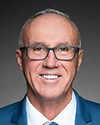Good morning, and thank you very much, Mr. Chair.
It's a real pleasure to be before the committee to talk about correctional issues. I'm extremely pleased that I have my colleague here from the AFN, the regional chief, newly elected and raring to go and working hard for the nation.
This morning I've not really prepared a whole lot of discussion in regard to formal notes, but I just wanted to have an open discussion and hopefully some good questions with regard to the treatment of indigenous offenders in the system in terms of their care and custody and conditional release.
I did want to let the committee know that I was a correctional executive for 10 years and was the primary architect of the national healing lodge strategy, as well as the Pathways strategy within, as well as others, including the national elders advisory committee.
This is an opportunity for me this morning to look back. It's been about 12 years since I left the service, and I'm trying to gauge how well those projects and initiatives worked. At the time, when I was in the service, there were only 1,400 indigenous offenders in the system. The issues they faced were obviously the same issues that they face today in regard to higher recidivism rates, higher classifications within the prison system, primarily being at high risk or medium risk, and not cascading through the system.
As part of the initiative, we certainly felt that under the new legislation at that time, under sections 81 and 84, there were some opportunities to engage the indigenous community—or at that time, the aboriginal community—and get them fully engaged in both the correctional aspect of housing and working with indigenous offenders, as well as doing the correctional release stuff, which was being looked after by the National Parole Board and the elder hearings.
I'm not surprised that the correctional service moved down a road to fully implement specific programs for men and women who find themselves in the correctional system. At that time, 12 or 14 years ago, it was very difficult for offenders to find themselves on a clean path, a well path, a healthy path out of prisons.
We took the initiative; I want to talk about how that initiative seems to have worked, but it seems to have not affected the flow in and out of prisons for indigenous people. The development of the healing lodge concept was really about moving high-risk offenders and cascading them through the system and getting them into community facilities such as Pê Sâkâstêw or Okimaw Ohci or Stan Daniels in Edmonton, and giving the first nations and Métis and Inuit communities the ability to truly deal with the unique issues that were faced by indigenous people and that continue to be faced by indigenous people.
Over the 10-year span when we started the program, we found success, but they were small successes, because in the system we were still having difficulty trying to understand indigenous issues, whether they were in the community or whether they were on the streets of Vancouver. There were the overwhelming issues of mental health, the overwhelming issues of growing up in a system that was foreign to them.
We did a study around 2000 that demonstrated that 95% of all men and women in the correctional system came through foster care. Look at the correlation in their developmental growth that was leading them down that road to what the second major issue is, which is that 75% to 80% of the crime being committed by indigenous people was under the influence of alcohol or drugs. It was a continuum of issues leading them into the criminal justice system, then through the courts, and then eventually into the prison system.
Corrections isn't about just corrections—this was our philosophy. Corrections is about what leads you to the road. It leads you down that road and into the prison system, and to a time when you leave that system.
Corrections is supposed to be about rehabilitation. It's supposed to be. I suspect it depends on which side of the coin you're on. It's also about incarceration. There has to be a better balance, a better understanding. I would say that within the context of indigenous issues and the Supreme Court v. Daniels, there are conditions and identifiable issues that could be dealt with in a much larger and much broader perspective. Corrections is only one component of the justice system.
You have to start at the beginning. You have to understand as a lawyer specialized in criminal law that there are conditions that lead people down the road. In today's society, we're now talking about reconciliation, getting healthier communities, engaging communities. You're talking with us about nation to nation and how we can truly address those issues. We've got to continue.
I won't sit here and bash the correctional system. The system is run by people. It's about people like you and me. I thought about something this morning: we're a long way from Millhaven. We're a long way in this room from Pê Sâkâstêw. What brought you to this table, and why is it such a short road for indigenous people to another table behind bars? We've got to think about that. We're got to deal with the best issues.
If this committee is looking at a study of what to do, look at the entire system. Government has to begin to address the issues of what effective indigenous, Métis, Inuit, first nation child care looks like, and maybe they will. I believe Minister Philpott is going to be pulling us all together in the new year to talk about building effective child and family services.
If those aren't there, the jails fill up. I remember writing in 2000, when there were 1,700 offenders, that by this time there would be 4,000, and I'm sad to say that there are 4,000. The systems have to change. It's my hope that this committee will look at what leads them there and what we can do for them, because I think the healing lodge program proved to be very successful for those who were really getting onto that healing path.
For the system within the medium- and high-security facilities, we created a program called Pathways. We tried to segregate indigenous offenders from the general population and get the elders and the programs that specifically target the issues faced by indigenous men and women.
I think there's a whole lot to dialogue about. We should have more that just 10 minutes. Obviously you have an important role to play here. You have to ask important questions. Open your mind to the entire system. I think the government as a whole and Canadians are moving toward a much more open reconciliation dialogue with indigenous people. I think our communities have some, not all, of the solutions. I think we just have to work together and define the path we need to be on. I don't want the road to be that short for our youth.
Terry and I were talking a little earlier about how our youth population is growing. We're the fastest-growing population in the country. I don't know what their future will be. Unfortunately, the reality is the future for some of them is going to be in penitentiaries, and we've got to stop that. We've got to figure out how we stop that, and it's got to be a more holistic view.
I look forward to questions. There's so much to talk about. There are so many things to do. I'll leave it at that and I'll turn it over to my colleague, Terry, the regional chief.




